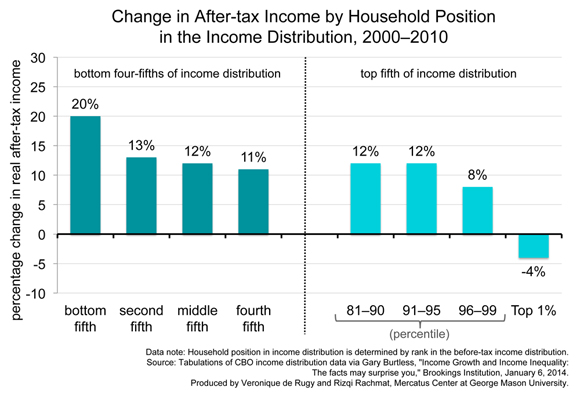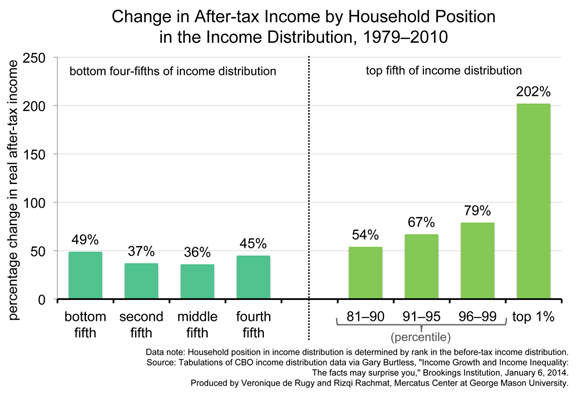- | Government Spending Government Spending
- | Data Visualizations Data Visualizations
- |
Trends in After-Tax Income by Household Position in the Income Distribution
Income equality and social mobility are important issues for many Americans. While many have been pessimistic about income distribution trends in recent years, arguing that the rich have gotten richer while low- and middle-incomes have been stagnating, the data reveal a more nuanced story.
Income equality and social mobility are important issues for many Americans. While many have been pessimistic about income distribution trends in recent years, arguing that the rich have gotten richer while low- and middle-incomes have been stagnating, the data reveal a more nuanced story.
This week’s charts use data from the Congressional Budget Office (CBO) assembled by Gary Burtless of the Brookings Institution to display trends in after-tax income changes by household income distribution in the medium and long terms. The first chart shows average cumulative after-tax income changes by income distribution from 2000 to 2010.
The CBO measures after-tax income as “the sum of market income and government transfers, minus federal tax liabilities.” The first four income quintiles, as determined by household position in before-tax income distribution, are displayed intact on the left side of the horizontal axis and the highest quintile in before-tax income distribution is separated into granular percentiles to the right side of the horizontal axis. The vertical axis measures the average percent cumulative change in real after-tax income for the decade analyzed.
The chart above shows that, contrary to popular belief, the richest 1 percent of Americans have not gotten richer during the past decade. In fact, the richest 1 percent of Americans are the only group whose incomes have truly shrunk, falling by an average of 4 percent. The incomes of all other groups have grown during this same period, and in fact the incomes of the lowest quintile have actually grown the most at 20 percent. All other income quintiles or percentiles grew by 8 to 13 percent during the first decade of the new millennium.
Burtless suggests that part of this trend can be explained by the 2008 recession. While all Americans were affected by the downturn, the richest 1 percent of Americans derived a larger share of their incomes from financial gains than other income groups and therefore stood to lose more in the downturn. Indeed, the CBO reports that incomes of Americans in the top percentile contracted by more than one third during the years of the recession. On the other hand, the top 1 percent of Americans also earned the highest portion of the income gains in 2010 as financial markets slowly recovered. In general, the highest earners in America were the only group who saw their after-tax incomes shrink on average in the past decade.
The second chart displays the same information over a long-term time horizon. From 1979 to 2010, the top 1 percent did indeed enjoy massive gains in average after-tax income growth, but the average incomes of all other quintiles grew considerably as well. The average income of the top 1 percent grew 202 percent. The average incomes of the bottom four quintiles also grew more modestly, but still substantially, ranging from 36 to 49 percent between 1979 and 2010. The average incomes of the second and middle quintiles grew at rates of 37 percent and 36 percent, respectively—slightly lower than average income growth of the bottom and fourth quintiles. Average incomes of Americans in the 81st through 99th percentiles grew at a slightly higher range of 54 to 79 percent.
One reason why so many Americans believe that the average incomes of middle- and low-income Americans have stagnated and that the average incomes of the top 1 percent always rise is that the commonly cited income statistics from the Census Bureau only consider before-tax income. This approach understates the well-being of Americans who receive income tax subsidies and overstates the well-being of Americans whose incomes are heavily taxed. Analyzing after-tax income levels provides a clearer picture of income trends in the United States, particularly as the tax code is frequently employed to redistribute income as a matter of policy.



